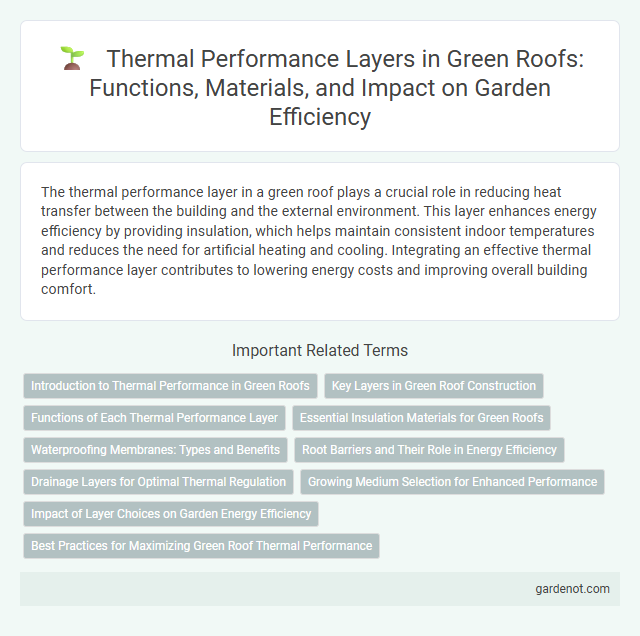The thermal performance layer in a green roof plays a crucial role in reducing heat transfer between the building and the external environment. This layer enhances energy efficiency by providing insulation, which helps maintain consistent indoor temperatures and reduces the need for artificial heating and cooling. Integrating an effective thermal performance layer contributes to lowering energy costs and improving overall building comfort.
Introduction to Thermal Performance in Green Roofs
Thermal performance in green roofs significantly reduces heat transfer through the building envelope by utilizing vegetation and soil as insulating layers. The thermal performance layer minimizes energy consumption by regulating indoor temperatures, thereby enhancing building energy efficiency. This layer also mitigates urban heat island effects by absorbing solar radiation and reducing surface temperatures.
Key Layers in Green Roof Construction
The thermal performance layer in green roof construction primarily consists of insulation materials such as rigid foam boards or mineral wool that reduce heat transfer and enhance energy efficiency. These materials maintain stable indoor temperatures by minimizing heat loss in winter and heat gain in summer, contributing significantly to the building's overall thermal regulation. Proper installation of the thermal performance layer ensures long-term durability and optimal functionality of the green roof system.
Functions of Each Thermal Performance Layer
The thermal performance layer in green roofs consists of insulation, waterproofing, and root barrier components that work together to regulate temperature and protect the building structure. Insulation minimizes heat transfer, maintaining interior comfort by reducing heating and cooling energy demands. The waterproofing layer prevents moisture infiltration, while the root barrier safeguards insulation and roofing materials from root damage, ensuring long-term durability and thermal efficiency.
Essential Insulation Materials for Green Roofs
Essential insulation materials for green roofs include rigid foam boards, mineral wool, and spray foam, which significantly enhance the thermal performance layer by reducing heat transfer and improving energy efficiency. These materials provide high R-values, moisture resistance, and durability, critical for protecting underlying structures from temperature fluctuations and moisture infiltration. Proper selection and installation of insulation optimize the green roof's ability to regulate indoor temperatures and lower building energy costs.
Waterproofing Membranes: Types and Benefits
Waterproofing membranes in green roofs are critical for thermal performance, preventing water infiltration while enhancing insulation efficiency. Common types include bituminous, polymeric (such as EPDM and PVC), and liquid-applied membranes, each offering durability and flexibility suited for varying climate conditions. These membranes not only protect structural integrity but also contribute to energy savings by maintaining stable indoor temperatures and reducing heat transfer.
Root Barriers and Their Role in Energy Efficiency
Root barriers in green roof systems act as critical thermal performance layers by preventing root intrusion into insulation materials, preserving their thermal integrity and energy efficiency. These barriers reduce heat transfer between the building interior and the external environment, contributing to lower heating and cooling demands. Effective root barrier installation enhances the overall energy-saving benefits of green roofs by maintaining consistent insulation properties.
Drainage Layers for Optimal Thermal Regulation
Drainage layers within green roofs enhance thermal performance by effectively managing water flow and preventing excess moisture buildup, which can compromise insulation properties. These layers facilitate rapid water drainage, reducing thermal conductivity and maintaining stable internal temperatures. Optimal thermal regulation in green roofs relies on high-quality drainage materials that support moisture control and promote energy efficiency.
Growing Medium Selection for Enhanced Performance
Selecting a well-engineered growing medium with high water retention and thermal mass is crucial for optimizing green roof thermal performance. Incorporating lightweight aggregates and organic matter improves insulation properties while mitigating heat transfer and temperature fluctuations. Proper medium composition enhances energy efficiency by reducing cooling loads and maintaining stable rooftop temperatures.
Impact of Layer Choices on Garden Energy Efficiency
The thermal performance layer in green roofs plays a critical role in enhancing garden energy efficiency by regulating heat transfer between the building and the environment. Selecting high-insulation materials such as mineral wool or expanded polystyrene significantly reduces thermal conductivity, maintaining stable indoor temperatures and lowering energy consumption for heating and cooling. Proper integration of this layer also improves the microclimate within the garden, promoting plant health and reducing urban heat island effects.
Best Practices for Maximizing Green Roof Thermal Performance
Optimal thermal performance in green roofs is achieved by integrating high-quality insulation materials that minimize heat transfer and selecting drought-resistant vegetation to maintain consistent evapotranspiration rates. Incorporating a well-designed growing medium with appropriate depth enhances thermal mass, stabilizing indoor temperatures and reducing energy consumption. Regular maintenance ensures plant health and substrate integrity, which are vital for sustaining the green roof's thermal benefits throughout seasonal variations.
Thermal performance layer Infographic

 gardenot.com
gardenot.com